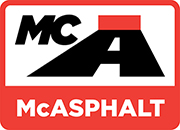Recycled Asphalt Mixes
Mixes can be made with 100% recycled asphalt pavement (RAP). These mixes are economically and environmentally friendly. Recycled asphalt mixes utilize RAP that can be crushed, graded, mixed, and laid on-site using custom-engineered rejuvenating emulsions.
Design Criteria
When designing a recycled asphalt mix, a number of factors have to be examined and assessed to ensure a proper mixture will be placed that will perform for its intended service life. The following factors can have a tremendous effect on the performance of a recycled asphalt mix: RAP material, virgin aggregate shape and type, mix workability, coating ability, and residual asphalt content.
RAP Material:
The RAP material is typically processed RAP taken from milling operations. The material can be split into coarse and fine RAP then blended back to make a better gradation. The physical properties of the recycled material (asphalt content, gradation of RAP, gradation of extracted RAP, and recovered penetration) should be determined.
Virgin Aggregate Shape and Type:
The overall shape of the virgin aggregate can influence the quantity of aggregate as well as the amount of asphalt emulsion to be used. The more graded the aggregate is, the higher the emulsion quantity needed. The compatibility of the emulsion used with the aggregate is critical.
Mix Workability:
The emulsion used should give the finished mix enough workability to be placed in a homogeneous condition and be designed for the intended method of processing, be it immediate placement or in a stockpile for future use.
Coating Ability:
The asphalt emulsion should have the ability to coat the fine aggregate in the mix (passing the 4.75 mm sieve) without the fine aggregate balling up. With some emulsions, the use of mixing water will aid in coating fine particles. The use of emulsions containing solvent will aid in coating and dust penetration as well as aid in the workability of the mix.
Asphalt Residual in the Emulsion:
The quantity of asphalt residual in the emulsion can affect the quantity of asphalt emulsion needed to coat the aggregate. The lower the residual, the higher the quantity of asphalt emulsion needed.
During the design process, two key factors are needed: a well-coated mix and a mix with adequate strength and stability to be able to handle the expected traffic load and volume.
A recycled asphalt mix typically requires an emulsion content of 1.0 to 4.0% (depending on the design parameters), a minimum of 2500 N stability at 25°C, and air voids of 7 to 11%.
Materials
Asphalt Emulsions:
Several factors have to be taken into account when choosing the emulsion to be used. The type and grade of emulsion required is affected by the RAP material, the virgin aggregate, the emulsion’s coating ability, the compatibility between materials, the mixing method used, the environmental conditions, and the laying and compaction process. The most widely used grades of asphalt emulsion in recycled asphalt mixes are SS-1, CSS-1, MS-2, CMS-2, HF150, and HF150M. In recent years, proprietary emulsions including rejuvenating emulsions have been developed for use in these recycled mixes.
Mix Aggregate:
The virgin aggregate used in blended recycled asphalt mixes can be processed or semi-processed crusher, pit, or bank run aggregates. Most are graded from a maximum size of 25 mm, have very low clay content, and do not have an excessive amount of material passing the 75 µm sieve. The recycled asphalt material can be screened or unscreened RAP material from grinding projects or processed RAP piles. It is preferable to fractionate the RAP and recombined as necessary to have a better control over its final gradation and the overall mix properties.
Performance Guidelines
In order to construct a proper, well-designed recycled asphalt mix, the following guidelines should be followed:
- Ensure the existing pavement structure or base material are adequate to support expected traffic
- Determine the type of mixing process (central plant, blade mixing, travel plant, pugmill) to be used
- Ensure the emulsion grade and type to be used is well-designed for the chosen mixing process
- Design a recycled asphalt mix with materials to be used on job
- If required, use a clay-free, hard, crushed aggregate with a well-graded appearance
- Ensure the asphalt emulsion and aggregate are compatible
- Ensure an adequate amount of emulsion is used
- Ensure the aggregate is moist but not saturated. This will reduce surface tension between the emulsion and the stone to promote uniform coatings and proper adhesion
- Ensure that the mix is workable and the fines are well coated
- Calibrate and inspect all equipment
- Use a sufficient number of properly weighted pneumatic and steel rollers in static mode
- Follow proper construction techniques
- Use traffic control to protect the mix
- Work only in weather suitable for the type and grade of emulsion being used
- Once the mix is cured, it should be covered with a thin wearing surface such as a chip seal, cape seal, slurry seal, sand seal or micro-surfacing

